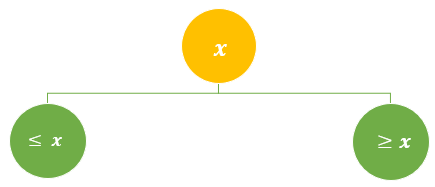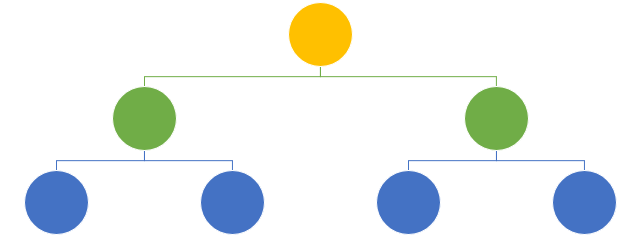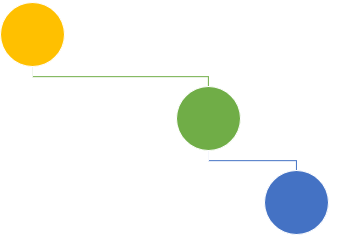Binary search tree basics
A Binary search tree (often abbreviated as “BST”) is an abstract data structure. It is also called an ordered/sorted binary tree.
The general property of the BST is: at each node, it is greater or equal to its left child but is less or equal to its right child. It can be summarized in graph below:
Its setup is very intuitive from the mathematical perspective: divide and conquer, or recursion, or induction, you name it.
For a sorted array/list, if we know that x is bigger than the median, then we don’t need to spend time on the left half. On the right half, we divide and conquer again.
 Of course, it is made for doing something better than other data structures :)
Of course, it is made for doing something better than other data structures :)
Height of tree is the length of the longest path between the root and leaf. Or, the number of nodes from root to leaf, not including the leaf itself. Or the number of edges connecting from root to leaf.
In a balanced tree, \(height = log(n)\)
In the extreme case it becomes a single linked list, as shown below, \(height = n\).
height of node is the length of the longest path between the node and leaf.
Local rule
\[\text{height of node}=max{\text{height of left child},\text{height of right child}}+1\]Whenever we have local rules that depend on the children only, we get constant overhead: store node height for free.
Our goal is to keep the tree’s height small (we want short/bushy trees), quivalently, the heights of the children equal. Cascading down, it means to keep heights of left and right children of every node to differ by at most \(+-1\).
Keeping tree balanced
There are many ways to keep trees balanced, AVL is the original method discovered in the 1960s. AVL trees use node heights (i.e. heights of left and right children).
An AVL tree (named after inventors Adelson-Velsky and Landis in 1962) is a self-balancing BST.
In table Below we compare the abstract data structure of array and Binary search tree:
| Compare | array | Binary search tree |
|---|---|---|
| size | fixed at birth | can change from insertion/deletion |
| storage | static in continuous block of memory allocated during compile time | dynamic, nodes are located at run time |
| ordering/sorting | fast direct access via index | sequential, transverse from the head node via link (next) |
| search | binary and linear search | linear search |
Binary search trees uses
The primary use of BST is searching: find the min and max elements, and find the next largest or smallest element.
They are useful when we need fast insertion and deletion, and when we do not know in advance the size of data, or do not need random access when searching for items.
- Time complexity:
- Search time is proportional to \(O(h)\), where \(h\) is height of tree.
- The insert, delete and search take \(O(log(n))\).
Tree traversing/walking
Depth first search (DFS)
Depth first as much as possible before going to the next sibling.
Let N represent “node”, “L” represent “left”, and “R” represent “right”.
There are \(3!\) different DFS because of permutation of NLR.
- In-order traversal:
When data is stored sorted a BST, in-order traversal retrieves the data in ascending sorted order. Hence the name “in order”.
Inorder DFS LNR: Left -> node -> right
- Recursively traverse the current node’s left subtree.
- Visit the current node (in the figure: position green).
- Recursively traverse the current node’s right subtree.
Conversey, Reverse in-order, RNL retrieves data in descending order:
- Recursively traverse the current node’s right subtree.
- Visit the current node.
- Recursively traverse the current node’s left subtree.
| Order | Vertical direction |
|---|---|
| In-order LNR | Up |
| Pre-order NLR | Down |
| Post_order LRN | Up |
Libraries
- sortedcontainers module.
- Underlying data structure: sorted list of sorted list
- Time complexity: \(O(\sqrt{n})\) (as compared with \(O(log(n))\) for balanced binary search tree)
Binary search tree implementation in Python
Python does not have a built-in binary search tree.
There can be many different ways to implement this. All of them have 2 parts: Node and Tree.
The most complicated is for the delete function because we need to account for different situations.
class Node(object):
def __init__(self, data = None):
self.data = data
self.leftChild = None
self.rightChild = None
def minValueNode(self, node):
current = node
# loop down to find the leftmost leaf
while(current.leftChild is not None):
current = current.leftChild
return current
def maxValueNode(self, node):
current = node
# loop down to find the rightmost leaf
while(current.rightChild is not None):
current = current.rightChild
return current
def insert(self, data):
''' For inserting the data in the Tree '''
if self.data == data: # check if already has this data, if so, reject insert
return False
elif data < self.data:
if self.leftChild: # check if already has left child
return self.leftChild.insert(data)
else:
self.leftChild = Node(data)
return True
else:
if self.rightChild: # check if already has right child
return self.rightChild.insert(data)
else:
self.rightChild = Node(data)
return True
def delete(self, data,root):
''' For deleting the node '''
if self is None:
return None
# if current node's data is less than that of root node, then only search in left subtree else right subtree
if data < self.data:
self.leftChild = self.leftChild.delete(data,root) # recursive
elif data > self.data:
self.rightChild = self.rightChild.delete(data,root) # recursive
else:
# deleting node with one child
if self.leftChild is None:
if self == root: # if no left child, then find the min from right side
temp = self.minValueNode(self.rightChild)
self.data = temp.data
self.rightChild = self.rightChild.delete(temp.data,root)
temp = self.rightChild
self = None
return temp
elif self.rightChild is None:
if self == root:
temp = self.maxValueNode(self.leftChild)
self.data = temp.data
self.leftChild = self.leftChild.delete(temp.data,root)
temp = self.leftChild
self = None
return temp
# deleting node with two children
# first get the inorder successor
temp = self.minValueNode(self.rightChild)
self.data = temp.data
self.rightChild = self.rightChild.delete(temp.data,root)
return self
class Tree(object):
def __init__(self):
self.root = None
def insert(self, data):
if self.root:
return self.root.insert(data)
else:
self.root = Node(data)
return True
def delete(self, data):
if self.root is not None:
return self.root.delete(data,self.root)
def find(self, data):
if self.root:
return self.root.find(data)
else:
return False
def preorder(self):
if self.root is not None:
print()
print('Preorder: ')
self.root.preorder()
def inorder(self):
print()
if self.root is not None:
print('Inorder: ')
self.root.inorder()
def postorder(self):
print()
if self.root is not None:
print('Postorder: ')
self.root.postorder()
tree = Tree()
tree.insert(3)
tree.insert(1)
tree.insert(7)
tree.insert(2)
tree.insert(4)
tree.insert(5)
tree.insert(9)
tree.insert(6)
tree.insert(8)
print(tree.find(1))
# True
print(tree.find(20))
# False
tree.preorder()
# Out:
# Preorder:
# 3 1 2 7 4 5 6 9 8
tree.inorder()
# Out:
# Inorder:
# 1 2 3 4 5 6 7 8 9
''' Following tree is getting created:
3
/ \
1 9
/ \ \
2 2 20
/
15
/
13
'''
tree.preorder()
tree.inorder()
tree.postorder()
trint('\n\nAfter deleting 20')
tree.delete(20)
tree.inorder()
tree.preorder()
trint('\n\nAfter deleting 10')
tree.delete(10)
tree.inorder()
tree.preorder()




